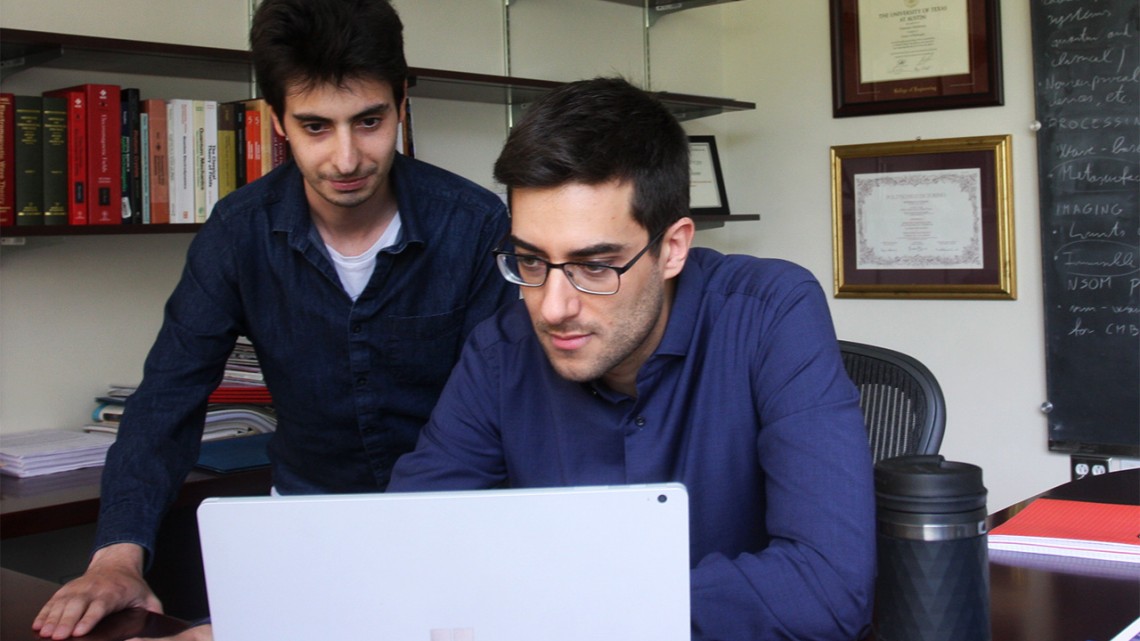
Francesco Monticone, assistant professor in the School of Electrical and Computer Engineering (right), and doctoral student Zeki Hayran.
Metamaterials research challenges fundamental limits in photonics
By Eric Laine
Cornell researchers are proposing a new way to modulate both the absorptive and the refractive qualities of metamaterials in real time, and their findings open intriguing new opportunities to control, in time and space, the propagation and scattering of waves for applications in various areas of wave physics and engineering.
The research published in the journal Optica, “Spectral Causality and the Scattering of Waves,” is authored by doctoral students Zeki Hayran and Aobo Chen, M.S. ’19, along with their adviser, Francesco Monticone, assistant professor in the School of Electrical and Computer Engineering in the College of Engineering.
The theoretical work aims to expand the capabilities of metamaterials to absorb or refract electromagnetic waves. Previous research was limited to modifying either absorption or refraction, but the Monticone Research Group has now shown that if both qualities are modulated in real time, the effectiveness of the metamaterial can be greatly increased.
These temporally modulated metamaterials, sometimes referred to as “chrono-metamaterials,” may open unexplored opportunities and enable technological advances in electromagnetics and photonics.
“What we demonstrate,” Monticone said, “is that if you modulate both properties in time, you manage to absorb electromagnetic waves much more efficiently than in a static structure, or in a structure in which you modulate either one of these two degrees of freedom individually. We combined these two aspects together to create a much more effective system.”
The findings may lead to the development of new metamaterials with wave absorption and scattering properties that far outperform what is currently available. For example, a broadband absorber has to be thicker than a certain value to be effective, but the material thickness will limit the applications of the design.
“To decrease the thickness and increase the bandwidth of such an absorber, you have to overcome the limitations of conventional materials,” Hayran said. “One of the ways to bypass these limitations is through temporally modulating the structure.”
The aim of Monticone’s group is to open new areas of research to produce increasingly efficient practical applications.
“What we are trying to do is not incremental changes to the technology,” Monticone said. “We want disruptive changes. That’s really what motivates us. So how can we make a dramatic improvement to the technology, not just an incremental improvement? To do that, very often, you have to go back to the fundamentals.”
The new research pushes the limits of electromagnetic wave absorption by using another degree of freedom, which is modulation in time, something not typically done in this area, but now receiving increasing research attention.
With a new theoretical underpinning in place, experimentally implementing temporal modulations of this kind is the challenge for further research. A physical experiment would first need to design a mechanism to control the modulation of absorptive and refractive qualities of a material over time, which might include laser beams or microwave components.
The ideas have direct implications for several applications, such as broadband radar absorption and temporal invisibility and cloaking. Applications could also extend to other domains of wave physics such as acoustics and elastodynamics.
“Our findings, and the exciting results by other researchers working in this area, highlight the many opportunities offered by time-varying metamaterials for both classical and quantum electromagnetics and photonics,” Monticone said.
This research is supported by the Air Force Office of Scientific Research and the National Science Foundation. Additional support is provided through the Fulbright Foreign Student Program of the U.S. Department of State.
Eric Laine is a communications specialist in the School of Electrical and Computer Engineering.
Media Contact
Get Cornell news delivered right to your inbox.
Subscribe